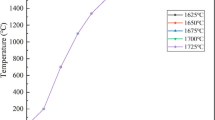Conclusions
The deformation rate of a corundum ceramic made from exceptionally pure material is lower than that of a ceramic made from commercial Al2O3 containing various impurities (overall amount 0.1–0.2%).
The magnitude of Q and n entering in the empirical creep law, and also the dependence of deformation rate on grain size, undergo practically no change during the use of exceptional-purity material as opposed to material of commercial purity. At the same time, the magnitude of the S factor for the pure material is somewhat lower, which results in an overall lowering of the deformation rate of such a ceramic.
The addition of MgO (introduced to control the crystal structure of corundum ceramic) does not cause the negative effect on creep as is caused by typical uncontrolled impurities in the starting commercial raw material. It may be assumed that the effect on creep of impurities in the commercial corundum ceramic is connected with an apparent rate increase of bulk diffusion in the corundum crystal lattice.
Similar content being viewed by others
Literature cited
R. L. Coble, J. Appl. Phys.,34, No. 6, 1679 (1963).
I. Vasilos et al., J. Amer. Ceram. Soc.,47, No. 4, 203 (1964).
S. I. Warshau and F. H. Norton, J. Amer. Ceram. Soc.,45, No. 10, 479 (1962).
R. L. Coble and Y. H. Guerard, J. Amer. Ceram. Soc.,46, No. 7, 353 (1963).
I. S. Kainarskii et al., Transactions Ukr. Scientific-Research Institute for Refractories [in Russian], No. 8 (1965), p. 3.
Van Buren, Defects in Crystals [Russian translation], IL (1962).
V. S. Bakunov and D. N. Poluboyarinov, Ogneupory, No. 1, 39 (1967).
I. B. Wachtman and L. H. Maxwell, Bull. ASTM,24 (211), 38 (1956).
J. E. Dorn and D. V. Mout, in: New Materials and Methods for Studying Metals and Alloys [Russian translation], Izd. Metallurgiya (1966).
J. E. Dorn, in: Creep and Recovery [Russian translation], Metallurgizdat (1961).
C. Zener and I. A. Holloman, Trans. ASM,33, 163 (1944).
R. M. Spriggs et al., J. Amer. Ceram. Soc.47, No. 7, 323 (1964).
R. L. Coble, J. Amer. Ceram. Soc.,45, 123 (1962).
É. V. Degtyareva, Izvestiya Akad. Nauk SSSR, Neorganicheskie Materialy, No. 2, 281 (1965).
Author information
Authors and Affiliations
Additional information
Translated from Ogneupory, No. 10, pp. 45–49, October, 1969.
Rights and permissions
About this article
Cite this article
Bakunov, V.S., Poluboyarinov, D.N., Popil'skii, R.Y. et al. Creep in a polycrystalline alumina ceramic of increased purity. Refractories 10, 643–646 (1969). https://doi.org/10.1007/BF01295358
Issue Date:
DOI: https://doi.org/10.1007/BF01295358



